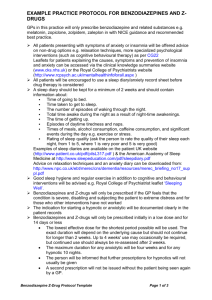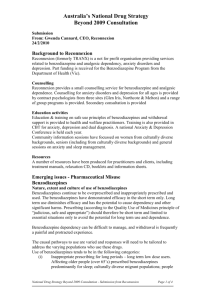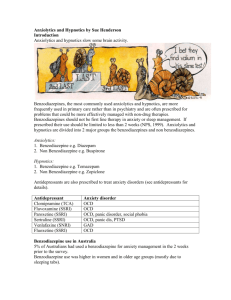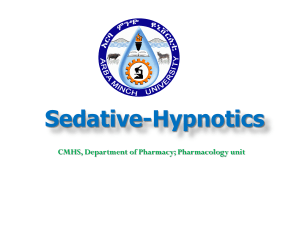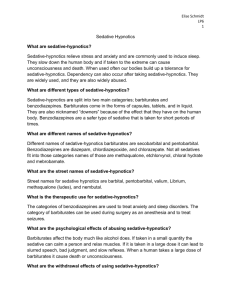Sedative- Hypnotic Drugs
advertisement
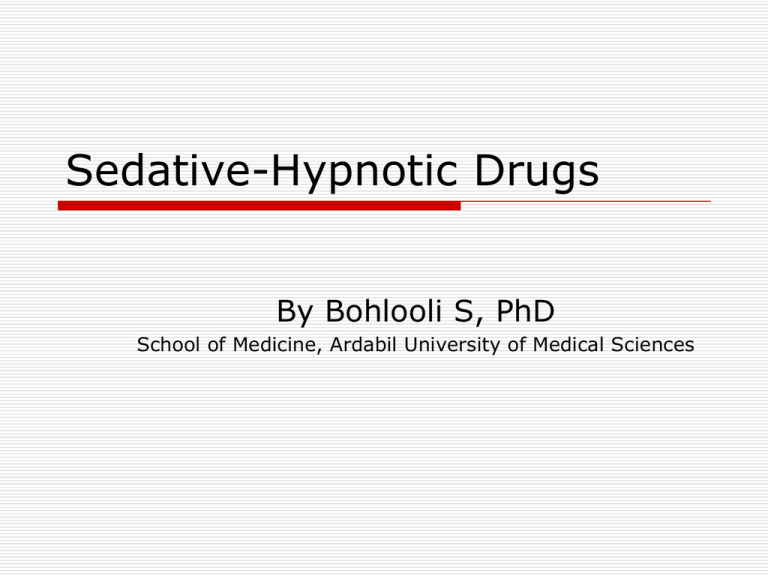
Sedative-Hypnotic Drugs By Bohlooli S, PhD School of Medicine, Ardabil University of Medical Sciences Dose-response curves for two hypothetical sedative-hypnotics BASIC PHARMACOLOGY OF SEDATIVE-HYPNOTICS CHEMICAL CLASSIFICATION Pharmacokinetics Pharmacodynamics CHEMICAL CLASSIFICATION: Benzodiazepines 1,4-benzodiazepines carboxamide group in the 7-membered heterocyclic ring structure A substituent in the 7 position, such as a halogen or a nitro group Barbiturates and other older drugs Several drugs with novel chemical structures Other classes of drugs antipsychotics , antidepressants , antihistaminics Chemical structures of benzodiazepines Chemical structures of barbiturates and other sedative-hypnotics Chemical structures of newer hypnotics Pharmacokinetics ABSORPTION AND DISTRIBUTION BIOTRANSFORMATION Benzodiazepines Barbiturates Newer hypnotics EXCRETION FACTORS AFFECTING BIODISPOSITION Biotransformation of benzodiazepines Pharmacokinetic properties of some benzodiazepines and newer hypnotics in humans Drug Peak Blood Level (hours) Elimination 1 Half-Life (hours) Comments Alprazolam 1-2 12-15 Rapid oral absorption Chlordiazepoxide 2-4 15-40 Active metabolites; erratic bioavailability from IM injection 1-2 (nordiazepam) 50-100 Prodrug; hydrolyzed to active form in stomach 1-2 20-80 Active metabolites; erratic bioavailability from IM injection Eszopiclone 1 6 Flurazepam 1-2 40-100 Active metabolites with long half-lives Lorazepam 1-6 10-20 No active metabolites Oxazepam 2-4 10-20 No active metabolites Temazepam 2-3 10-40 Slow oral absorption Triazolam 1 2-3 Rapid onset; short duration of action Zaleplon <1 1-2 Metabolized via aldehyde dehydrogenase Zolpidem 1-3 1.5-3.5 Clorazepate Diazepam 1 Includes half-lives of major metabolites. Minor active metabolites No active metabolites Pharmacodynamics RAMELTEON BUSPIRONE MOLECULAR PHARMACOLOGY OF THE GABAA RECEPTOR NEUROPHARMACOLOGY BENZODIAZEPINE BINDING SITE LIGANDS ORGAN LEVEL EFFECTS RAMELTEON Melatonin receptors are thought to be involved in maintaining circadian rhythms underlying the sleepwake cycle Ramelteon, a novel hypnotic drug prescribed specifically for patients who have difficulty in falling asleep Is an agonist at MT1 and MT2 melatonin receptors located in the suprachiasmatic nuclei of the brain. Adverse effects of ramelteon include dizziness, somnolence, fatigue, and endocrine changes as well as decreases in testosterone and increases in prolactin. BUSPIRONE Buspirone relieves anxiety without causing marked sedative, hypnotic, or euphoric effects. As a partial agonist at brain 5-HT1A receptors, No rebound anxiety or withdrawal signs on abrupt discontinuance. The anxiolytic effects of buspirone may take more than a week to become established The drug is used in generalized anxiety states but is less effective in panic disorders. The major metabolite is 1-(2-pyrimidyl)-piperazine (1-PP), which has alpha-2-adrenoceptor-blocking actions MOLECULAR PHARMACOLOGY OF THE GABAA RECEPTOR MOLECULAR PHARMACOLOGY OF THE GABAA RECEPTOR Assembled from five subunits Oolypeptide classes (a, b, g, d, e, p, r, etc). six different a, four b, and three g Two a1 and two b2 subunits and one g2 subunit Zolpidem, zaleplon, and eszopiclone bind more selectively: interact only with GABAA-receptor isoforms that contain a1 subunits NEUROPHARMACOLOGY GABA (gamma-aminobutyric acid) is the major inhibitory neurotransmitter The benzodiazepines do not substitute for GABA an increase in the frequency of channel-opening events Barbiturates also facilitate the actions of GABA to increase the duration of the GABA-gated chloride channel openings may also be GABA-mimetic depress the actions of excitatory neurotransmitters BENZODIAZEPINE BINDING SITE LIGANDS Agonists benzodiazepines Antagonists benzodiazepine derivative flumazenil Inverse agonists the b-carbolines ORGAN LEVEL EFFECTS Sedation Hypnosis Anesthesia Anticonvulsant effects Muscle relaxation Effects on respiration and cardiovascular function Sedation Calming effects Depressant effects on psychomotor and cognitive functions Dose-dependent anterograde amnesic effects Hypnosis Benzodiazepines the latency of sleep onset is decreased (time to fall asleep) the duration of stage 2 NREM sleep is increased the duration of REM sleep is decreased the duration of stage 4 NREM slow-wave sleep is decreased Zolpidem decreases REM sleep but has minimal effect on slowwave sleep Zaleplon decreases the latency of sleep onset with little effect on total sleep time Eszopiclone increases total sleep time, mainly via increases in stage 2 NREM sleep Anesthesia Barbiturates thiopental and methohexital Benzodiazepines: diazepam, lorazepam, and midazolam a persistent postanesthetic respiratory depression reversible with flumazenil Anticonvulsant effects Benzodiazepines: clonazepam, nitrazepam, lorazepam, and diazepam Barbiturates: phenobarbital and metharbital Zolpidem, zaleplon, and eszopiclone lack anticonvulsant activity Muscle relaxation Members of the carbamate meprobamate Benzodiazepine groups Diazepam Effects on respiration and cardiovascular function Patients with pulmonary disease significant respiratory depression In hypovolemic states, heart failure, and other diseases cause cardiovascular depression Tolerance; Psychologic & Physiologic Dependence Tolerance partial cross-tolerance Mechanism An increase in the rate of drug metabolism down-regulation of brain benzodiazepine receptors Dependence relief of anxiety, euphoria, disinhibition, and promotion of sleep lead to misuse Physiologic Dependence States of Increased anxiety Insomnia central nervous system excitability The severity of withdrawal symptoms depends on: the magnitude of the dose relate in part to half-life Triazolam: daytime anxiety BENZODIAZEPINE ANTAGONISTS: FLUMAZENIL Competitive antagonists Blocks many of the actions of Benzodiazepines Zolpidem Zaleplon eszopiclone Reversing the CNS depressant effects Hasten recovery Flumazenil acts rapidly but has a short halflife May cause a severe precipitated abstinence syndrome CLINICAL PHARMACOLOGY OF SEDATIVE-HYPNOTICS TREATMENT OF ANXIETY STATES TREATMENT OF SLEEP PROBLEMS OTHER THERAPEUTIC USES TREATMENT OF ANXIETY STATES Secodary Anxiety States Secondary to organic disease Secondary to situational states as premedication Generalized anxiety disorder(GAD) Panic disorders Agoraphobia Acute anxiety states Panic attacks TREATMENT OF SLEEP PROBLEMS Sleep of fairly rapid onset Sufficient duration With minimal "hangover" effects Drowsiness Dysphoria Mental or motor depression Dosages of drugs used commonly for sedation and hypnosis Sedation Drug Hypnosis Dosage Drug Dosage (at Bedtime) Alprazolam (Xanax) 0.25-0.5 mg 2-3 times daily Chloral hydrate 500-1000 mg Buspirone (BuSpar) 5-10 mg 2-3 times daily Estazolam (ProSom) 0.5-2 mg Chlordiazepoxide (Librium) 10-20 mg 2-3 times daily Eszopiclone (Lunesta) 1-3 mg Clorazepate (Tranxene) 5-7.5 mg twice daily Lorazepam (Ativan) 2-4 mg Diazepam (Valium) 5 mg twice daily Quazepam (Doral) 7.5-15 mg Halazepam (Paxipam) 20-40 mg 3-4 times daily Secobarbital 100-200 mg Lorazepam (Ativan) 1-2 mg once or twice daily Temazepam (Restoril) 7.5-30 mg Oxazepam 15-30 mg 3-4 times daily Triazolam (Halcion) 0.125-0.5 mg Phenobarbital 15-30 mg 2-3 times daily Zaleplon (Sonata) 5-20 mg Zolpidem (Ambien) 5-10 mg Clinical uses of sedative-hypnotics For relief of anxiety For insomnia For sedation and amnesia before and during medical and surgical procedures For treatment of epilepsy and seizure states As a component of balanced anesthesia (intravenous administration) For control of ethanol or other sedative-hypnotic withdrawal states For muscle relaxation in specific neuromuscular disorders As diagnostic aids or for treatment in psychiatry CLINICAL TOXICOLOGY OF SEDATIVE-HYPNOTICS Direct Toxic Actions dose-related depression of the central nervous system Hypersensitivity reactions teratogenicity Alterations in Drug Response Tolerance Cross-tolerance Drug Interactions With other central nervous system depressant drugs hepatic drug-metabolizing enzyme systems
